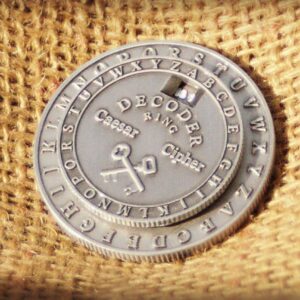
Virtual Decoder Medallion
The Sunstone decoder medallion is designed to solve Vigenere and Caesar ciphers. Those are fancy names, but don’t worry – all they do is shift the alphabet over by a few letters. Here are four ways to crack them:
-
You can actually decipher vigenere and caesar codes with just a pencil and paper. Watch this video to see how.
-
Copy/Paste! If you’ve been typing the clues somewhere, you can decode them using this ROT13 website. It’s simple: input your code into the box, then count how far you’re shifting the alphabet (for this cipher, A=0, B=1… Z=25), and choose that number from the ROT13 dropdown. The website will translate it for you. (Note – the alphabet can rotate two different ways – so if at first you don’t succeed shifting forwards, you might have success shifting backwards.)
-
With the decoder medallion, just turn the dial so the correct number shows up in the window, then see which letter lines up with the one you’re trying to solve.
-
You can also use the virtual decoder we’ve provided below. Decoding a letter is as simple as finding the right row and column. Just like Battleship.
See more detailed instructions and hints below.
Instructions:
Remember, all we’re doing is shifting the alphabet over by a couple of letters. In order to crack a code, you’ll need two things:
-
A series of letters or numbers to be decoded (for example, “CPFH”)
-
A series of letters or numbers to use as the key (for example, the numbers 0123)
These are the numbers and letters on the medallion, or the columns and rows in the chart above. Once you have both pieces of the puzzle, you’re ready to solve it. Spin the decoder medallion or play Battleship with the Vigenere grid above to translate one letter at a time. Here’s how:
-
Use the first number in the key to adjust the dial. In the example above, turn the dial to show the number 0. If using the grid, find the column labeled 0.
-
Next, find the first letter of the encoded word in the outside ring of the medallion, or in the row of the Vigenere grid. in our case, we’re looking for the letter C.
-
Write down the letter you see on the inside ring under the chosen letter – or the letter in the grid where your selected row and column intersect. In this case, our first decoded letter is C.
-
Repeat the process until all of the letters are decoded. In our example, we find the following:
-
number 1 and outside letter P = inside letter O
-
number 2 and outside letter F = inside letter D
-
number 3 and outside letter H = inside letter E
-
-
String all of the decoded letters together to get your answer. In this example, the answer is “CODE.”
Additional Hints:
Vigenere ciphers can be tricky, so here are a few things to keep in mind:
-
In the example above, the key was four digits long, and each number was used to decode a single letter of the puzzle. But remember, keys can come in all different shapes and sizes. It could just be a single number. For example, you can also decipher the word “CODE” by using the encoded letters “RDST” and the key number 15.
-
The key doesn’t have to be numerical – it can also be a letter, a series of letters, or even a word or phrase. When using letters, remember to find the key letter on the inside ring and line it up with the letter A on the outside ring. If it’s easier, you can also convert the letters into numbers using the two left columns of the Vigenere chart above.
-
You’ve seen how to use the outside letters to find solution letters in the inside ring. Don’t panic, but Vigenere cyphers can also work in reverse. Just line up the rings using the key as you’ve been shown – but the encoded letter will now be on the inside ring, and the solution letter on the outside ring. If using the grid, locate the encoded letter in the same row as the key letter/number, and then find the solution letter in the top row.
-
Remember, there are two things you need in order to crack a code. If you have the encoded letters but you don’t yet have the key, be patient. Some adventures weren’t meant to be solved on the first day.
Good luck, Adventurers!

